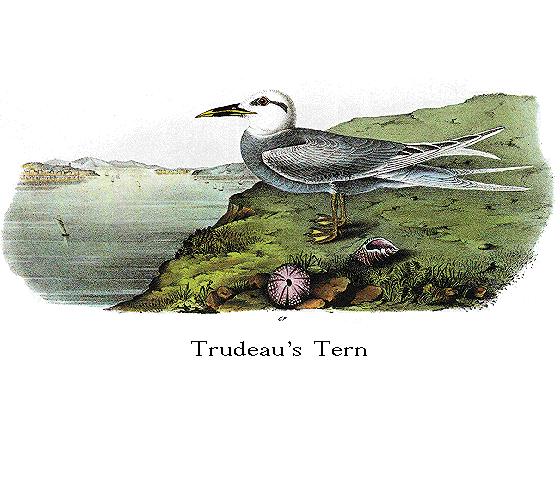Birds of America
By John James Audubon, F. R. SS. L. & E.
VOLUME VII.



Family
Genus

TRUDEAU'S TERN.
[Trudeau's Tern.]
STERNA TRUDEAUII, Aud.
[Sterna trudeaui.]

PLATE CCCCXXXV.--ADULT.
This beautiful Tern, which has not hitherto been described, was procured at
Great Egg Harbour in New Jersey, by my much esteemed and talented friend, J.
TRUDEAU, Esq. of Louisiana, to whom I have great pleasure in dedicating it.
Nothing is known as to its range, or even the particular habits in which it may
differ from other species. The individual obtained was in the company of a few
others of the same kind. I have received from Mr. TRUDEAU an intimation of the
occurrence of several individuals on Long Island.
TRUDEAU'S TERN, Sterna Trudeaui, Aud. Orn. Biog., vol. v. p. 125.
Adult, 16; wing, 10 10/12.
Great Egg Harbour and Long Island. Rare. Migratory.
Adult in winter plumage.
Bill about the length of the head, rather slender, much compressed,
acuminate. Upper mandible with the dorsal line slightly declinato-convex, the
ridge rather broad and convex at the base, very narrow in the rest of its
extent, the sides sloping at the base, nearly erect and convex toward the end,
the edges sharp and inflected, the tip very narrow. Nasal groove rather short,
but with a slight channel, surmounted by a ridge, running from its anterior part
to the edge of the mandible about three-fourths of an inch from the tip. Lower
mandible with the angle long, very narrow, and pointed, the outline of the crura
a little concave, that of the rest ascending and straight, a very slight
prominence or angle being formed at their junction, the sides erect and slightly
convex, the edges sharp and inclinate, the tip acuminate, the gap-line slightly
arcuate.
Head of moderate size, ovato-oblong, neck of moderate length; body slender.
Feet small; tibia bare for half an inch; tarsus very short, compressed,
anteriorly scutellate; toes small, slender; the first extremely small, the third
longest, the fourth much longer than the second, all scutellate above, the
anterior connected by reticulate webs, of which the inner is more deeply
emarginate. Claws moderately arched, compressed, very slender towards the end,
that of the middle toe much larger, and having its inner edge somewhat dilated.
Plumage soft, close, blended, very short on the fore part of the head.
Wings very long, narrow, and pointed; primary quills tapering to an obtuse
point; the first longest, the second half an inch shorter, the rest rapidly
graduated; secondaries short, incurved, obliquely pointed, some of the inner
proportionally longer and narrower. Tail of moderate length, deeply forked, of
twelve feathers, of which the middle are rounded, and three inches shorter than
the outer, which taper to a slender point.
Bill black, with part of the base of the lower mandible, the edges of both
mandibles, and their tips to the length of five-twelfths of an inch, yellow.
Iris brown. Feet orange-yellow; claws dusky-yellow. Surrounding the eye, and
extending toward the nape, is a band of blackish-grey; the fore part of the
head, the lower eyelid, the cheeks, and the upper part of the throat, are white.
The rest of the upper and lower parts are light greyish-blue, excepting the
axillar feathers, the lower wing-coverts, and the rump, which are white; the
tail-coverts and tail are greyish-white. The primary coverts and quills are
hoary, but the outer five are dusky-grey on the inner web, toward the margin,
and less so along the shaft, and on the outer web; but the shafts of all the
quills and tail-feathers are white, as are the inner edges of the primaries and
the tips of the secondaries, the inner excepted.
Length to end of tail 16 inches; to end of wings 15; bill along the ridge
1 8/12, along the edge of lower mandible 2 5/12; wing from flexure 10 10/12;
tail to end of middle feather 2 8/12, to end of lateral feather 5 8/12; tarsus
1 (1/4)/12; hind toe 3/12, its claw (1 1/2)/12; middle toe 10/12, its claw
(4 1/4)/12.
This species has the bill more slender than Havell's Tern, and differently
coloured, the tarsus shorter, and the lower parts of the body and neck of the
same tint as the upper, whereas that species is white beneath.
It is probable that both species have the upper part of the head and the
nape black in summer.









